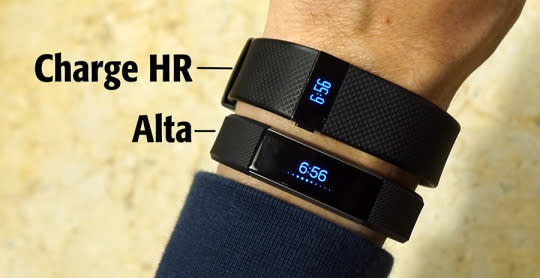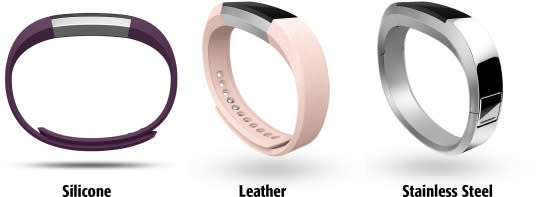Fitbit Alta: Fitness-tracking goes super-stylish
Fitness wristbands are what you’d call a stealth blockbuster. We, the people, bought 17 million of these things last year, and IDC predicts we’ll be buying 125 million of them a year by 2019. You’re already seeing them on a heck of a lot of wrists these days. They make us healthier by making visible something that has always been invisible: the inner workings of our own bodies.
Yet it must be distressing to Fitbit, the world’s biggest wearables maker, to see so many wrists still bare. The explanation, frankly, is obvious: Nobody has yet made the perfect fitness tracker.
We want certain physical characteristics: Easy to put on and take off, stylish, showerproof, long battery life, and inexpensive. We’d like a screen that shows the time and other stats, so we don’t have to pull out our phones all the time to check our progress. Many women, and the small of wrist in general, would prefer something slim and unobtrusive.
We also want a complete set of features. We want a wearable that accurately tracks our steps and our sleep; counts the stairs we’ve climbed; monitors our heart rate; reminds us to move around for a couple of minutes after we’ve been sitting for too long, and notifies us (with vibrations and screen messages) of incoming calls, text messages, and calendar appointments. We want a great app that presents all our health stats clearly and flexibly. Oh, and we want to be able to share our stats with friends and family from that app, because competition is a great motivator.
Is that so much to ask?
Fitbit’s new Alta band ($130) doesn’t offer all of that — no band does. It does, however, strike a new spot on the features spectrum, one that no fitness band has ever hit before.

Meet the Alta
All kinds of things tell you that the Alta is designed for everyday consumers who just want some healthy motivation; it’s not for health nuts or athletes. It emphasizes slim good looks, and de-emphasizes data collection.
First, the good news. The Alta is the skinniest Fitbit band ever — about half the width of the Charge band. It seems to take direct aim at Jawbone’s Up band, which has always been super-skinny and therefore a lot less ugly than rivals.

But here’s a twist: You can pop out the Alta’s brain module to insert it into a different band.

You can choose that band in a different silicone color ($30; black, blue, plum, or teal), a leather one ($60; pink or gray), or even a stainless-steel, bangle-type band ($100; coming this spring) that takes fitness trackers into a whole new realm of jewelry-ishness.

The OLED screen is big and bright and beautiful, and easy to read in any light. You can choose the kind and orientation of its time display:

Unfortunately, the screen is ordinarily turned off. To see the time, you either double-tap the Alta or raise your wrist; there’s no physical Wake button, as there is on Fitbit’s other products. (This would have been fine if it meant that the Alta, which now has no physical holes in its shell, was showerproof. Alas, it’s not. Grrr.)
Once you’ve awakened the Alta, each additional screen tap summons a different tally for the day: Steps, miles, calories burned, minutes active.

It’s not a touchscreen. The Alta detects your taps solely from the jostling of the entire unit, and it sometimes takes several frustrating attempts to register a tap.
On the other hand, what’s super great is that the Alta vibrates when your phone gets an incoming call or text — and scrolls the actual text message — or when a calendar appointment comes due. (You can turn off any of these notification categories if you wish.)
In other words, the Alta takes one small step into Smartwatch Land. The screen shows only about 12 characters at a time, but they scroll at a nicely readable speed. If you’ve never experienced it, you can’t imagine how useful it is to be able to see and notice incoming calls and texts, even when your phone is buried in your bag or over there on the table.

The Alta’s band closes around your wrist using a system of pegs and holes. Popping it off is super quick — you just yank on the end of the strap — but putting it on is fussy, at least at first.

The Alta goes about six days on a charge. You charge it up from a proprietary USB cable (from your computer or a wall plug). Among fitness bands, this is one of the most easily connected, thanks to its handy spring-loaded “mouth”:

Unfortunately, to make the Alta small and inexpensive, and to give it long battery life, Fitbit left out two great features from its fancier (and bigger) models: stairway counting and heart-rate monitoring.
Heart rate is an important indicator of how efficiently you’re exercising and how healthy your heart is overall (based on your resting heart rate). A heart monitor greatly enhances the accuracy of a tracker’s calorie-burn calculations, too.
In general, heart-rate monitors on a wristband eat up space and battery life — so the Alta does without.
Special features
The Alta does, however, add something new to the Fitbit lineup: reminders to move.
Over 10,000 studies have established how deadly it is to sit for long chunks of your day. It’s really terrible for you. Sit six hours a day, and you’ll die 4.8 years sooner than you would otherwise. That’s true even if you exercise regularly; this article explains why.
Sitting also makes you fat, reduces bone density, contributes to heart disease, and makes you less productive.
The latest science, however, says that just moving a little once every hour goes a long way toward fighting off those awful outcomes. That’s why many Garmin bands and the Apple Watch give you reminders, after every hour of sitting, to move for a couple of minutes.
The Alta does that, too. If you’ve been sitting for 50 minutes nonstop, you get a little buzz on the wrist and a message on the screen suggesting that you get up and walk at least 250 steps (about two minutes). Your compliance with that advice shows up in the app like a scorecard:

You can turn off this feature, and you can set up “Do not disturb” times when you won’t be nagged. But, man, this feature is exceptionally well implemented. It really, truly works. Turns out you don’t have to think very hard to come up with an hourly excuse to get up and go do something, thus making your app happy.
(The scorecard of hours will come to other Fitbit models soon — but the actual, on-wrist reminders are unique to the Alta and the new Fitbit Blaze smartwatch.)
The Alta also inherits the very smart ability of other Fitbits to detect when you’re exercising, and to record it correctly. In fact, by analyzing the particular movement patterns of your wrist, it knows which kind of exercise you’re doing: biking, hiking, running, or playing basketball, soccer, or tennis. It automatically records that exercise, which is really slick.

The Alta attitude
I’m a hardcore fan of the Fitbit Charge HR, so I’ll just come right out and say it: Having worn the Alta for a week, I miss the heart monitoring.
In exchange, though, I get the joy of the phone notifications on my wrist, which are fantastic. And I get a much better-looking piece of hardware that takes up much less space on my wrist.
It probably isn’t a surprise that most of the women who’ve seen my sample Alta say they prefer its looks to some of the other Fitbits. And indeed, women seem to be Fitbit’s target demographic; most of its advertising and sample photos show the Alta on women.

Now, the Alta isn’t the first skinny fitness band. The Up 3 band ($100) is also skinny and fashionable, and it can sort of track your heart rate — but it has no screen, so of course you can’t check your progress without pulling out your phone.
(You know what really sounds cool? The Garmin VivoFit 3 ($100), coming in a few months. It’s not quite as narrow as the Alta, but it otherwise seems like it will do everything: show phone notifications, remind you when you’ve been sitting too long, take interchangeable bands, go a year on a battery. And get this: It will be waterproof! Swim, shower — go nuts.)
Finally, there are all the watch-type fitness trackers, which are aimed at serious athletes and include the new Fitbit Blaze (my review of that is forthcoming).
If the Alta had been waterproof or included a heart-rate monitor, it would have made real headlines. It would have represented an inarguable leap forward in technology.
Instead, what it mostly does is stir around the stew of features and tradeoffs into a new configuration.
Still, that new recipe includes some truly delicious ingredients, including some of the most accurate, automated, easy-to-understand health tracking on the market, and an absolutely terrific app.

By putting all of that in a sleeker, slimmer, less intrusive package, Fitbit is betting that you’re more likely to keep wearing the Alta once you’ve tried it. This means more motivation and feedback, which means a healthier life.
In other words, the Alta doesn’t represent the ultimate fitness band — just the best that you can get in the slim-and-great-looking category.
David Pogue is the founder of Yahoo Tech; here’s how to get his columns by email. On the Web, he’s davidpogue.com. On Twitter, he’s @pogue. On email, he’s poguester@yahoo.com. He welcomes non-toxic comments in the Comments below.

